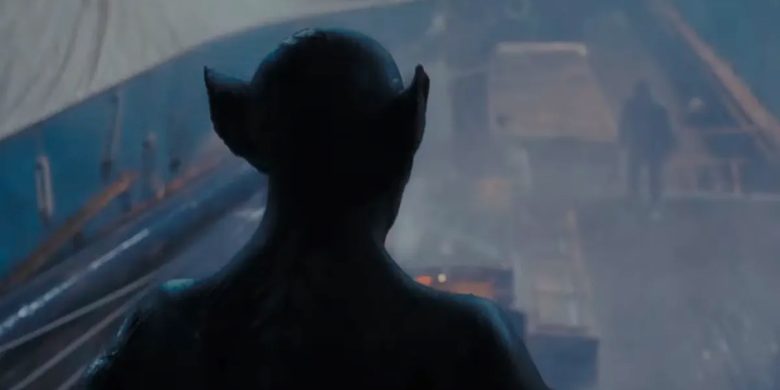by Eric Lindbom
In Bram Stoker’s DRACULA, the ghost ship Demeter docks in London minus a crew except for the dead captain tied to the helm wheel and its vampiric cargo eager to seek out new blood. THE LAST VOYAGE OF THE DEMETER (in theaters), a handsomely mounted, old fashioned period piece, focuses entirely on this single chapter from the novel.
Screenwriters Bragi F. Schut Jr. and Zak Olkewicz confine almost the entire film to the shipboard setting. A well-cast crew is led by our hero, an African-American doctor and astronomer who talks his way on board (Corey Hawkins who brought Dr. Dre to life in STRAIGHT OUTTA COMPTON). He’s aided by swarthy Slavs and two GAME OF THRONES veterans, imminently trustworthy Liam Cunningham (rocking mussel chopped sideburns) as the upright captain and Asling Franciosi as a headstrong prisoner who previously served as Dracula’s mini-fridge back home and is on board against her will.
Norwegian director André Øvredal is a seasoned horror deck hand whose past work includes TROLL HUNTER and THE AUTOPSY OF JANE DOE and he creates a palpable sense of dread particularly through vivid sound design; he employs an eerie motif where pounding out a rhythm by hand against the hull reverberates throughout the ship as a distress signal.
His, and the make up department’s, conception of Dracula is clearly influenced by F.W Murnau’s silent NOSFERATU (1923) and the bald head and pointed ears of Max Schreck’s Count Orloff (Murnau’s transparent name change didn’t spare his unauthorized film adaptation from a plagiarism charge). As in Murnau’s film, Dracula here carries the same aura of creepy pestilence. Even the rats on ship flee him.
In our meta-verse era it’s easy to accept the idea of multiple Batmans or Spidermans as well as Draculas. However, what makes Stoker’s creation come to life (from death) on screen are the takes of the various actors who’ve portrayed him. There are plenty to choose from, enjoy and debate: Bela Lugosi’s seductive Hungarian lilt, Christopher Lee’s violent physicality, the courtly manner and evil stare of John Carradine (who most closely resembles Stoker’s description), the anguish of Jack Palance, the romantic dandy Gary Oldham and on and on. The point being, when not in neck nibbling mode, any actor taking on the role gets to put his own stamp on the monster’s more sedate moments.
Here, in manic murder mode, Dracula mirrors a flying harpy or a blood thirsty insect more than a character. Javier Botet, a physically expressive actor, has essayed beasties in numerous other horrors including CRIMSON PEAK, THE MUMMY (2017 version) and the leper in IT CHAPTER ONE and his Drac strikes quickly with gymnastic grace. Yet, without a Renfield-styled servant/apologist at its side, this Dracula is a vampire minus the vamping.
The decision to focus exclusively on the death cruise prevents Dracula from being anything more than a killer in transit. Earlier filmmakers plumbed the Demeter chapter effectively and more concisely.
In the most chilling scene in NOSFERATU, a hatchet-wielding sailor cracks open a coffin and Orloff rises, stiff as a board, to full height. The frightened sailor jumps overboard as the vampire, talons at his side like a gun slinger, stalks the doomed captain ferociously. The similar scene in Todd Browning’s DRACULA (1931) pales by comparison. Anonymous ant-like sailors in raincoats bounce around the gale stormed deck like Keystone Kops, juiced by a sped up camera amidst static cutaways to Lugosi. The scene is handled with far more verve in the Spanish language version of DRACULA (1931) with close ups of terrified sailors.
THE LAST VOYAGE OF THE DEMETER vacillates between period-appropriate characters delivering forboding, Gothic dialogue and frenetic violence more befitting ALIEN or John Carpenter’s THE THING. DEMETER sank at the domestic box office, a possible hurdle being a visibility problem due to the WGA and SAG AFRA strikes which prevented the cast from publicizing it.
Universal (with help from its alignment with Blumhouse Productions) has enjoyed success with its string of fresh, successful horror films with big budgets that even garner strong notices from mainstream critics. Yet, other than a well executed reboot of THE INVISIBLE MAN, the studio has stumbled in its attempts to turn its classic monsters into franchise figures. Of those creations, Dracula seems the most amenable to ongoing sequels. Perhaps Nicolas Cage’s Drac will get another turn at ‘bat’ (his plumb RENFIELD turn deserved better in a horror comedy that too often forgot the funny). The nearly wordless gremlin in DEMETER hardly warrants a second life.
Eric Lindbom is a hardcore horror buff with a strong stomach, weaned on the Universal classics from the ’30s and ’40s. He’s written film and/or music reviews for City Pages, Twin Cities Reader, LA WEEKLY, Request magazine and Netflix. He co-edits triggerwarningshortfiction.com, a site specializing in horror, fantasy and crime short stories with illustrations by co-editor John Skewes. He lives in Los Angeles.







